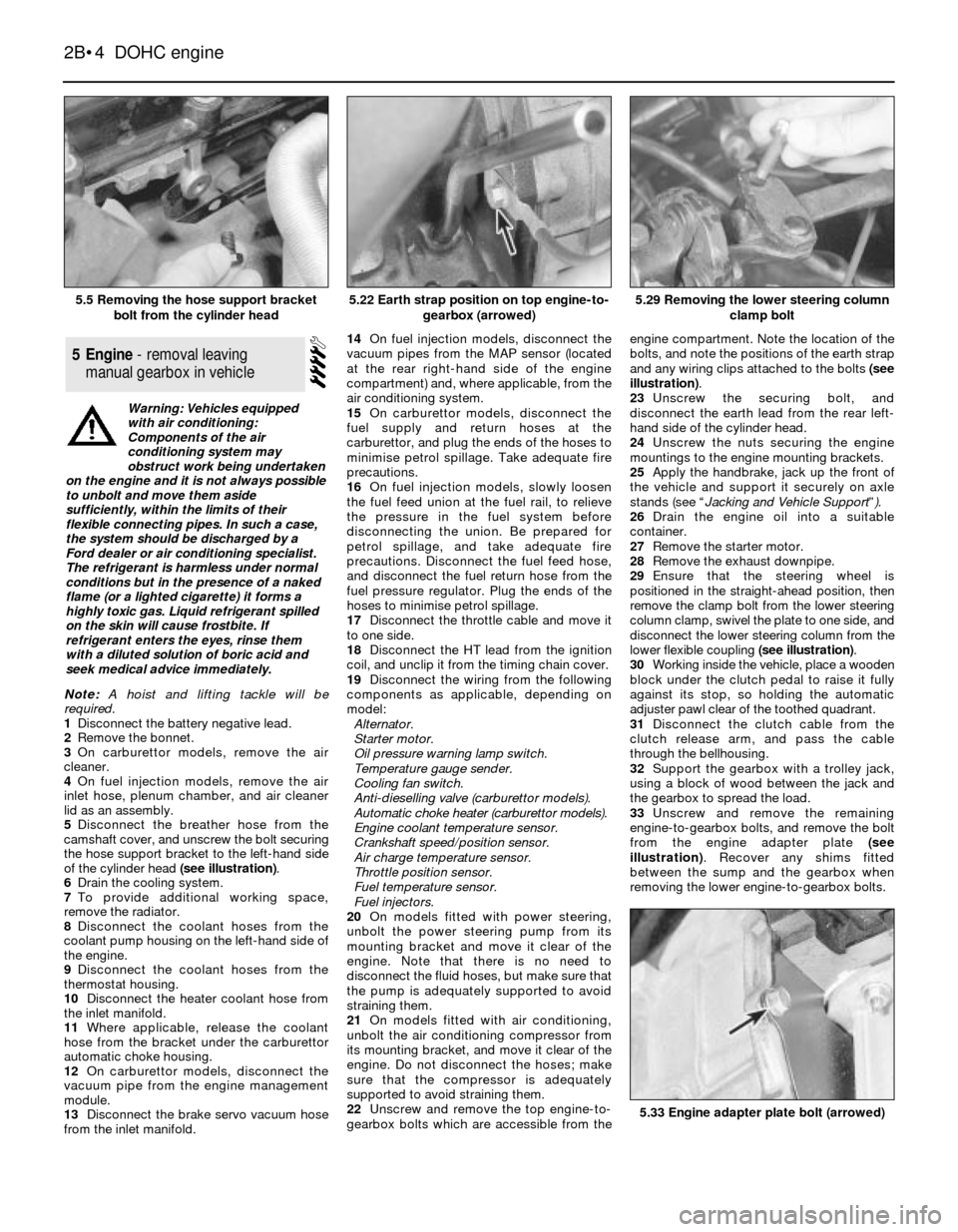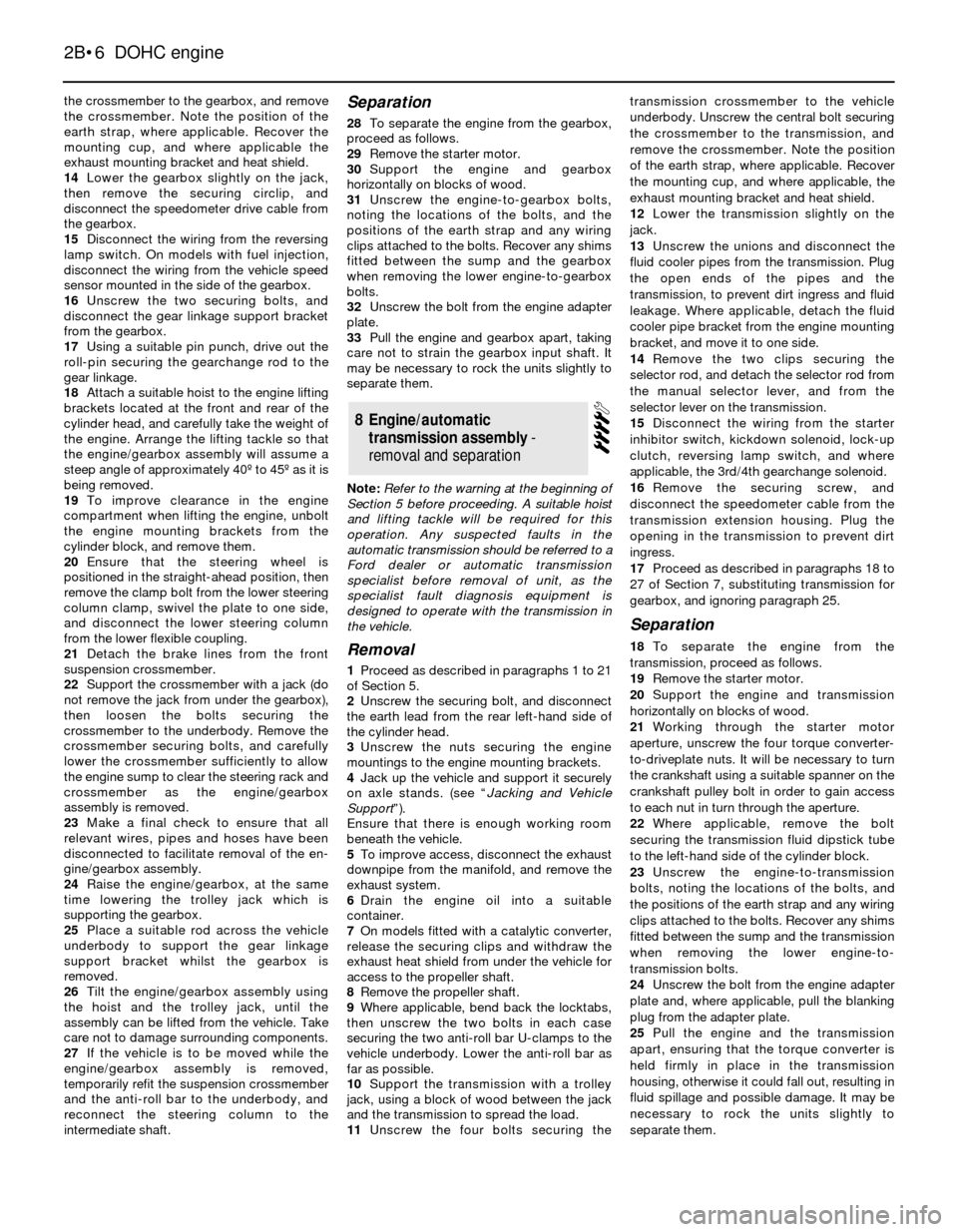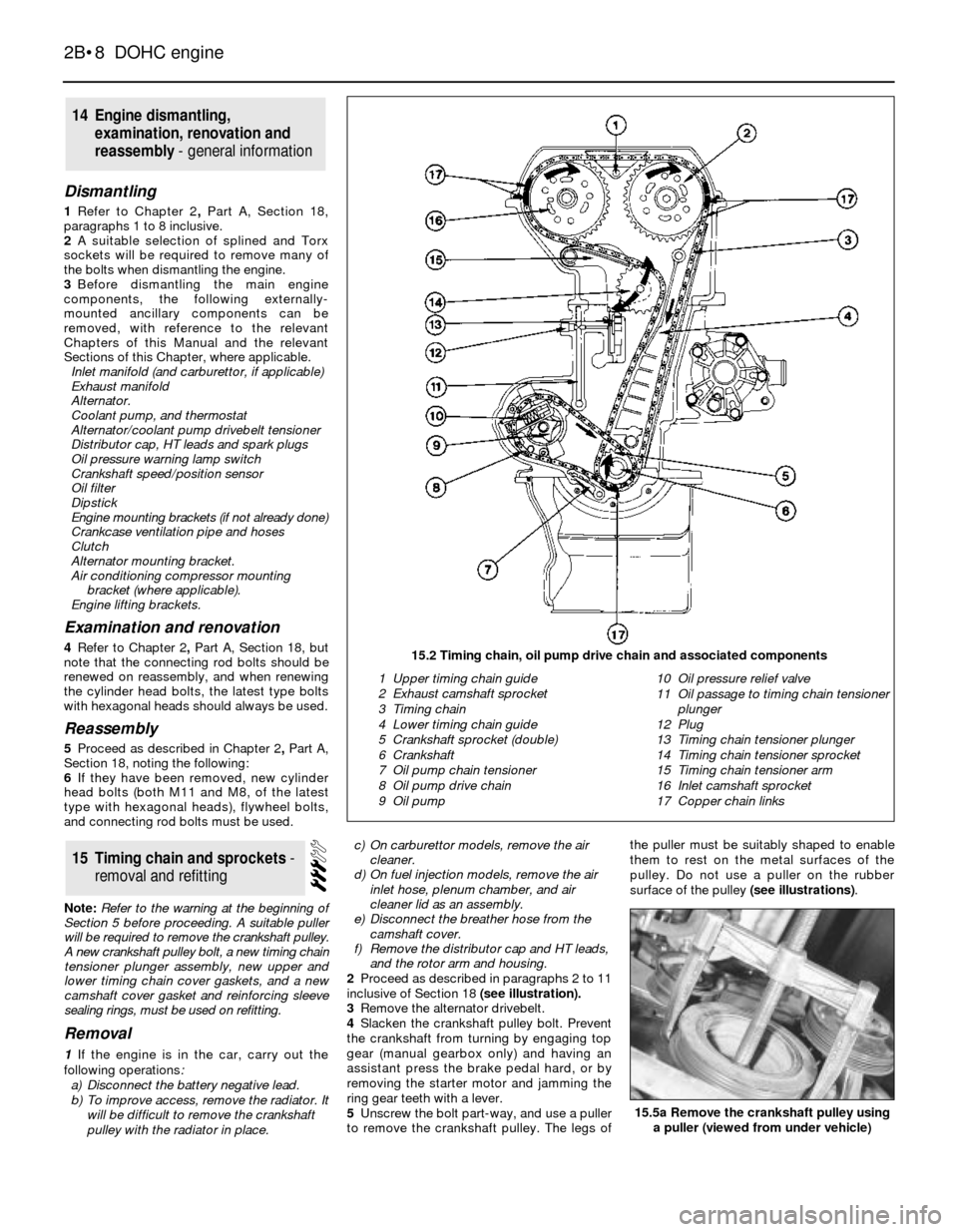brake sensor FORD SIERRA 1985 1.G DOHC Engine Workshop Manual
[x] Cancel search | Manufacturer: FORD, Model Year: 1985, Model line: SIERRA, Model: FORD SIERRA 1985 1.GPages: 18, PDF Size: 0.9 MB
Page 4 of 18

Note:A hoist and lifting tackle will be
required.
1Disconnect the battery negative lead.
2Remove the bonnet.
3On carburettor models, remove the air
cleaner.
4On fuel injection models, remove the air
inlet hose, plenum chamber, and air cleaner
lid as an assembly.
5Disconnect the breather hose from the
camshaft cover, and unscrew the bolt securing
the hose support bracket to the left-hand side
of the cylinder head (see illustration).
6Drain the cooling system.
7To provide additional working space,
remove the radiator.
8Disconnect the coolant hoses from the
coolant pump housing on the left-hand side of
the engine.
9Disconnect the coolant hoses from the
thermostat housing.
10Disconnect the heater coolant hose from
the inlet manifold.
11Where applicable, release the coolant
hose from the bracket under the carburettor
automatic choke housing.
12On carburettor models, disconnect the
vacuum pipe from the engine management
module.
13Disconnect the brake servo vacuum hose
from the inlet manifold.14On fuel injection models, disconnect the
vacuum pipes from the MAP sensor (located
at the rear right-hand side of the engine
compartment) and, where applicable, from the
air conditioning system.
15On carburettor models, disconnect the
fuel supply and return hoses at the
carburettor, and plug the ends of the hoses to
minimise petrol spillage. Take adequate fire
precautions.
16On fuel injection models, slowly loosen
the fuel feed union at the fuel rail, to relieve
the pressure in the fuel system before
disconnecting the union. Be prepared for
petrol spillage, and take adequate fire
precautions. Disconnect the fuel feed hose,
and disconnect the fuel return hose from the
fuel pressure regulator. Plug the ends of the
hoses to minimise petrol spillage.
17Disconnect the throttle cable and move it
to one side.
18Disconnect the HT lead from the ignition
coil, and unclip it from the timing chain cover.
19Disconnect the wiring from the following
components as applicable, depending on
model:
Alternator.
Starter motor.
Oil pressure warning lamp switch.
Temperature gauge sender.
Cooling fan switch.
Anti-dieselling valve (carburettor models).
Automatic choke heater (carburettor models).
Engine coolant temperature sensor.
Crankshaft speed/position sensor.
Air charge temperature sensor.
Throttle position sensor.
Fuel temperature sensor.
Fuel injectors.
20On models fitted with power steering,
unbolt the power steering pump from its
mounting bracket and move it clear of the
engine. Note that there is no need to
disconnect the fluid hoses, but make sure that
the pump is adequately supported to avoid
straining them.
21On models fitted with air conditioning,
unbolt the air conditioning compressor from
its mounting bracket, and move it clear of the
engine. Do not disconnect the hoses; make
sure that the compressor is adequately
supported to avoid straining them.
22Unscrew and remove the top engine-to-
gearbox bolts which are accessible from theengine compartment. Note the location of the
bolts, and note the positions of the earth strap
and any wiring clips attached to the bolts (see
illustration).
23Unscrew the securing bolt, and
disconnect the earth lead from the rear left-
hand side of the cylinder head.
24Unscrew the nuts securing the engine
mountings to the engine mounting brackets.
25Apply the handbrake, jack up the front of
the vehicle and support it securely on axle
stands (see “Jacking and Vehicle Support”).
26Drain the engine oil into a suitable
container.
27Remove the starter motor.
28Remove the exhaust downpipe.
29Ensure that the steering wheel is
positioned in the straight-ahead position, then
remove the clamp bolt from the lower steering
column clamp, swivel the plate to one side, and
disconnect the lower steering column from the
lower flexible coupling (see illustration).
30Working inside the vehicle, place a wooden
block under the clutch pedal to raise it fully
against its stop, so holding the automatic
adjuster pawl clear of the toothed quadrant.
31Disconnect the clutch cable from the
clutch release arm, and pass the cable
through the bellhousing.
32Support the gearbox with a trolley jack,
using a block of wood between the jack and
the gearbox to spread the load.
33Unscrew and remove the remaining
engine-to-gearbox bolts, and remove the bolt
from the engine adapter plate (see
illustration). Recover any shims fitted
between the sump and the gearbox when
removing the lower engine-to-gearbox bolts.
5Engine - removal leaving
manual gearbox in vehicle
2B•4DOHC engine
5.5 Removing the hose support bracket
bolt from the cylinder head5.29 Removing the lower steering column
clamp bolt
5.33 Engine adapter plate bolt (arrowed)
5.22 Earth strap position on top engine-to-
gearbox (arrowed)
Warning: Vehicles equipped
with air conditioning:
Components of the air
conditioning system may
obstruct work being undertaken
on the engine and it is not always possible
to unbolt and move them aside
sufficiently, within the limits of their
flexible connecting pipes. In such a case,
the system should be discharged by a
Ford dealer or air conditioning specialist.
The refrigerant is harmless under normal
conditions but in the presence of a naked
flame (or a lighted cigarette) it forms a
highly toxic gas. Liquid refrigerant spilled
on the skin will cause frostbite. If
refrigerant enters the eyes, rinse them
with a diluted solution of boric acid and
seek medical advice immediately.
Page 6 of 18

the crossmember to the gearbox, and remove
the crossmember. Note the position of the
earth strap, where applicable. Recover the
mounting cup, and where applicable the
exhaust mounting bracket and heat shield.
14Lower the gearbox slightly on the jack,
then remove the securing circlip, and
disconnect the speedometer drive cable from
the gearbox.
15Disconnect the wiring from the reversing
lamp switch. On models with fuel injection,
disconnect the wiring from the vehicle speed
sensor mounted in the side of the gearbox.
16Unscrew the two securing bolts, and
disconnect the gear linkage support bracket
from the gearbox.
17Using a suitable pin punch, drive out the
roll-pin securing the gearchange rod to the
gear linkage.
18Attach a suitable hoist to the engine lifting
brackets located at the front and rear of the
cylinder head, and carefully take the weight of
the engine. Arrange the lifting tackle so that
the engine/gearbox assembly will assume a
steep angle of approximately 40º to 45º as it is
being removed.
19To improve clearance in the engine
compartment when lifting the engine, unbolt
the engine mounting brackets from the
cylinder block, and remove them.
20Ensure that the steering wheel is
positioned in the straight-ahead position, then
remove the clamp bolt from the lower steering
column clamp, swivel the plate to one side,
and disconnect the lower steering column
from the lower flexible coupling.
21Detach the brake lines from the front
suspension crossmember.
22Support the crossmember with a jack (do
not remove the jack from under the gearbox),
then loosen the bolts securing the
crossmember to the underbody. Remove the
crossmember securing bolts, and carefully
lower the crossmember sufficiently to allow
the engine sump to clear the steering rack and
crossmember as the engine/gearbox
assembly is removed.
23Make a final check to ensure that all
relevant wires, pipes and hoses have been
disconnected to facilitate removal of the en-
gine/gearbox assembly.
24Raise the engine/gearbox, at the same
time lowering the trolley jack which is
supporting the gearbox.
25Place a suitable rod across the vehicle
underbody to support the gear linkage
support bracket whilst the gearbox is
removed.
26Tilt the engine/gearbox assembly using
the hoist and the trolley jack, until the
assembly can be lifted from the vehicle. Take
care not to damage surrounding components.
27If the vehicle is to be moved while the
engine/gearbox assembly is removed,
temporarily refit the suspension crossmember
and the anti-roll bar to the underbody, and
reconnect the steering column to the
intermediate shaft.Separation
28To separate the engine from the gearbox,
proceed as follows.
29Remove the starter motor.
30Support the engine and gearbox
horizontally on blocks of wood.
31Unscrew the engine-to-gearbox bolts,
noting the locations of the bolts, and the
positions of the earth strap and any wiring
clips attached to the bolts. Recover any shims
fitted between the sump and the gearbox
when removing the lower engine-to-gearbox
bolts.
32Unscrew the bolt from the engine adapter
plate.
33Pull the engine and gearbox apart, taking
care not to strain the gearbox input shaft. It
may be necessary to rock the units slightly to
separate them.
Note: Refer to the warning at the beginning of
Section 5 before proceeding. A suitable hoist
and lifting tackle will be required for this
operation. Any suspected faults in the
automatic transmission should be referred to a
Ford dealer or automatic transmission
specialist before removal of unit, as the
specialist fault diagnosis equipment is
designed to operate with the transmission in
the vehicle.
Removal
1Proceed as described in paragraphs 1 to 21
of Section 5.
2Unscrew the securing bolt, and disconnect
the earth lead from the rear left-hand side of
the cylinder head.
3Unscrew the nuts securing the engine
mountings to the engine mounting brackets.
4Jack up the vehicle and support it securely
on axle stands. (see “Jacking and Vehicle
Support”).
Ensure that there is enough working room
beneath the vehicle.
5To improve access, disconnect the exhaust
downpipe from the manifold, and remove the
exhaust system.
6Drain the engine oil into a suitable
container.
7On models fitted with a catalytic converter,
release the securing clips and withdraw the
exhaust heat shield from under the vehicle for
access to the propeller shaft.
8Remove the propeller shaft.
9Where applicable, bend back the locktabs,
then unscrew the two bolts in each case
securing the two anti-roll bar U-clamps to the
vehicle underbody. Lower the anti-roll bar as
far as possible.
10Support the transmission with a trolley
jack, using a block of wood between the jack
and the transmission to spread the load.
11Unscrew the four bolts securing thetransmission crossmember to the vehicle
underbody. Unscrew the central bolt securing
the crossmember to the transmission, and
remove the crossmember. Note the position
of the earth strap, where applicable. Recover
the mounting cup, and where applicable, the
exhaust mounting bracket and heat shield.
12Lower the transmission slightly on the
jack.
13Unscrew the unions and disconnect the
fluid cooler pipes from the transmission. Plug
the open ends of the pipes and the
transmission, to prevent dirt ingress and fluid
leakage. Where applicable, detach the fluid
cooler pipe bracket from the engine mounting
bracket, and move it to one side.
14Remove the two clips securing the
selector rod, and detach the selector rod from
the manual selector lever, and from the
selector lever on the transmission.
15Disconnect the wiring from the starter
inhibitor switch, kickdown solenoid, lock-up
clutch, reversing lamp switch, and where
applicable, the 3rd/4th gearchange solenoid.
16Remove the securing screw, and
disconnect the speedometer cable from the
transmission extension housing. Plug the
opening in the transmission to prevent dirt
ingress.
17Proceed as described in paragraphs 18 to
27 of Section 7, substituting transmission for
gearbox, and ignoring paragraph 25.
Separation
18To separate the engine from the
transmission, proceed as follows.
19Remove the starter motor.
20Support the engine and transmission
horizontally on blocks of wood.
21Working through the starter motor
aperture, unscrew the four torque converter-
to-driveplate nuts. It will be necessary to turn
the crankshaft using a suitable spanner on the
crankshaft pulley bolt in order to gain access
to each nut in turn through the aperture.
22Where applicable, remove the bolt
securing the transmission fluid dipstick tube
to the left-hand side of the cylinder block.
23Unscrew the engine-to-transmission
bolts, noting the locations of the bolts, and
the positions of the earth strap and any wiring
clips attached to the bolts. Recover any shims
fitted between the sump and the transmission
when removing the lower engine-to-
transmission bolts.
24Unscrew the bolt from the engine adapter
plate and, where applicable, pull the blanking
plug from the adapter plate.
25Pull the engine and the transmission
apart, ensuring that the torque converter is
held firmly in place in the transmission
housing, otherwise it could fall out, resulting in
fluid spillage and possible damage. It may be
necessary to rock the units slightly to
separate them.
8Engine/automatic
transmission assembly -
removal and separation
2B•6DOHC engine
Page 8 of 18

Dismantling
1Refer to Chapter 2, PartA, Section 18,
paragraphs 1 to 8 inclusive.
2A suitable selection of splined and Torx
sockets will be required to remove many of
the bolts when dismantling the engine.
3Before dismantling the main engine
components, the following externally-
mounted ancillary components can be
removed, with reference to the relevant
Chapters of this Manual and the relevant
Sections of this Chapter, where applicable.
Inlet manifold (and carburettor, if applicable)
Exhaust manifold
Alternator.
Coolant pump, and thermostat
Alternator/coolant pump drivebelt tensioner
Distributor cap, HT leads and spark plugs
Oil pressure warning lamp switch
Crankshaft speed/position sensor
Oil filter
Dipstick
Engine mounting brackets (if not already done)
Crankcase ventilation pipe and hoses
Clutch
Alternator mounting bracket.
Air conditioning compressor mounting
bracket (where applicable).
Engine lifting brackets.
Examination and renovation
4Refer to Chapter 2, PartA, Section 18, but
note that the connecting rod bolts should be
renewed on reassembly, and when renewing
the cylinder head bolts, the latest type bolts
with hexagonal heads should always be used.
Reassembly
5Proceed as described in Chapter 2, PartA,
Section 18, noting the following:
6If they have been removed, new cylinder
head bolts (both M11 and M8, of the latest
type with hexagonal heads), flywheel bolts,
and connecting rod bolts must be used.
Note: Refer to the warning at the beginning of
Section 5 before proceeding. A suitable puller
will be required to remove the crankshaft pulley.
A new crankshaft pulley bolt, a new timing chain
tensioner plunger assembly, new upper and
lower timing chain cover gaskets, and a new
camshaft cover gasket and reinforcing sleeve
sealing rings, must be used on refitting.
Removal
1If the engine is in the car, carry out the
following operations:
a)Disconnect the battery negative lead.
b)To improve access, remove the radiator. It
will be difficult to remove the crankshaft
pulley with the radiator in place.c)On carburettor models, remove the air
cleaner.
d)On fuel injection models, remove the air
inlet hose, plenum chamber, and air
cleaner lid as an assembly.
e)Disconnect the breather hose from the
camshaft cover.
f)Remove the distributor cap and HT leads,
and the rotor arm and housing.
2Proceed as described in paragraphs 2 to 11
inclusive of Section 18 (see illustration).
3Remove the alternator drivebelt.
4Slacken the crankshaft pulley bolt. Prevent
the crankshaft from turning by engaging top
gear (manual gearbox only) and having an
assistant press the brake pedal hard, or by
removing the starter motor and jamming the
ring gear teeth with a lever.
5Unscrew the bolt part-way, and use a puller
to remove the crankshaft pulley. The legs ofthe puller must be suitably shaped to enable
them to rest on the metal surfaces of the
pulley. Do not use a puller on the rubber
surface of the pulley (see illustrations).
15Timing chain and sprockets -
removal and refitting
14Engine dismantling,
examination, renovation and
reassembly - general information
2B•8DOHC engine
15.2 Timing chain, oil pump drive chain and associated components
1 Upper timing chain guide
2 Exhaust camshaft sprocket
3 Timing chain
4 Lower timing chain guide
5 Crankshaft sprocket (double)
6 Crankshaft
7 Oil pump chain tensioner
8 Oil pump drive chain
9 Oil pump10 Oil pressure relief valve
11 Oil passage to timing chain tensioner
plunger
12 Plug
13 Timing chain tensioner plunger
14 Timing chain tensioner sprocket
15 Timing chain tensioner arm
16 Inlet camshaft sprocket
17 Copper chain links
15.5a Remove the crankshaft pulley using
a puller (viewed from under vehicle)